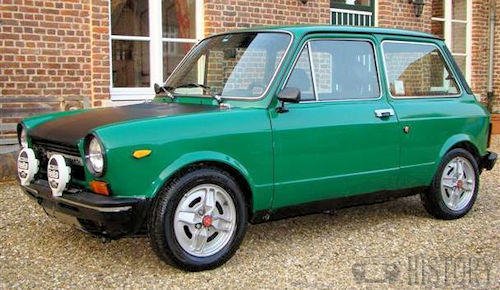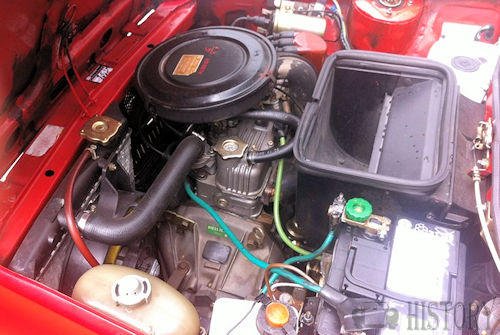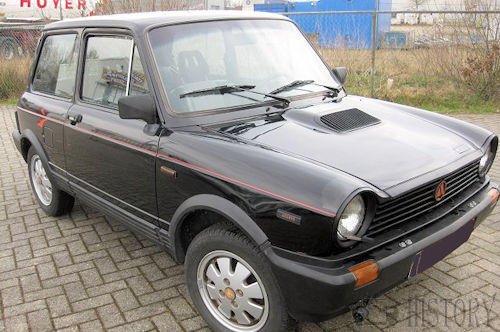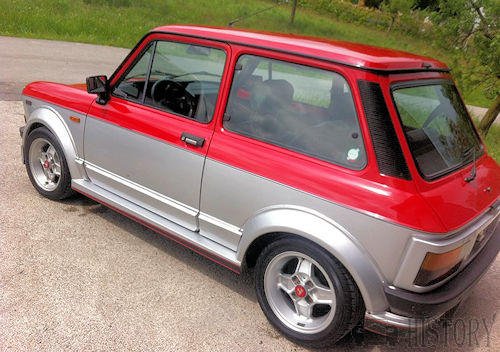Autobianchi A112 Abarth
| 1971 to 1984 | |
|---|---|
 |
|
| Overview | |
| Manufacturer | Autobianchi |
| Production | 1971–1984 |
| Designer | Marcello Gandini at Bertone |
| Body and chassis | |
| Class | Supermini (B) |
| Body style | 3-door hatchback |
| Powertrain | |
| Engine |
982 cc OHV I4 1050 cc OHV I4 |
| Transmission | 4-speed manual 5-speed manual |
| Dimensions | |
| Wheelbase | 2,038 mm (80.2 in) |
| Length | 3,230 mm (127.2 in) |
| Width | 1,480 mm (58.3 in) |
| Curb weight | 670 kg (1,477 lb) |
The A112 Abarth, introduced in September 1971 at the same time as the Elegant. It was prepared by the motorsports division of the Fiat Group, at first with a 982 cc engine, obtained by increasing the stroke, coupled to a sportive exhaust, a twin carburetor, and a different camshaft. In 1975, displacement was increased to 1,050 cc, while power climbed from 58 HP to 70 HP at 6600 rpm, for a weight of only 700 kg (1,540 lb).
The two engines were offered in parallel until production of the smaller unit ended in late 1976. The 1975 model was also the first A112 to use a 5-speed manual gearbox. These changes turned the A112 into a nervous machine, much admired by young performance enthusiasts.
PERFORMANCE: A112 Abarth 1,050 cc
- max speed: over 96 mph, 155 km/h
- max power (DIN): 70 hp (51 kW) at 6,600 rpm
- max torque (DIN): 64 1b ft. 8.8 kg m (87 Nm) at 4,200 rpm
- max engine rpm: 7,000; 66,7 hp/l (49.1 kW/l)
- power-weight ratio: 22.1 lb/hp (30 lb/kW), 10 kg/hp (13.6 kg/kW);
- acceleration: standing /4 mile 18.6 sec
- speed in top at 1,000 rpm: 16.8 mph, 27 km/h
- consumption: 36,7 m/imp gal, 30,5 m/US gal, 7.7 100 km at 75 mph, 120 km/h

The car was entered in various rallying events throughout Europe and even spawned a one-make trophy: the Campionato A112 Abarth spanned eight editions, from 1977 to 1984, and adopted contemporary Group 1 rules, which meant nearly-stock cars. Some famous Italian rally drivers, including Attilio Bettega, Fabrizio Tabaton and Gianfranco Cunico, were among the winners of the championship. The increasing popularity of the A112 in historic rallies and hillclimbs led to the reintroduction of a one-make trophy, called Trofeo A112 Abarth, in 2010. Abarths have often led hard lives, having been preferred by young owners with aggressive driving styles. Formula One driver Olivier Panis is one of many to have crashed an A112 Abarth.
Developments
First series: October 1969 - March 1973
In September 1971 . A performance edition "Abarth" was introduced
Second series: March 1973 - early 1975
In March 1973 the A112 received a makeover. The grille was new, with a larger mesh, and the bumpers were now of rubber with chrome insert The Abarth received a new chess pattern upholstery.
Third series: early 1975 - November 1977
In 1975 the third series arrived. redesigned taillights - with integrated reversing lights on the Elegant and Abarth. The Abarth also received a new larger 1050 cc engine ("70HP"), . All engines were still pushrod units, derived from the old tipo 100 engine first introduced in the Fiat 600. In 1976. This was the last model to have the diamond shaped turn signals on the front fenders, with later models receiving more orthodox rectangular ones.
Rayton Fissore showed (and then sold) a special-bodied version of the A112 called "Otas" in 1976, with aerodynamically styled bodywork reminiscent of that of the Porsche 928.
Fourth series: November 1977 - 1979
In November 1977 The most obvious difference is a slightly taller roof, with a marked edge around the sides. This improved interior habitability considerably.
Fifth series: 1979 - 1982
In July 1979 the car underwent another styling modification, receiving large black plastic cladding on the rear, surrounding new taillights, and new side trim and bumpers. The grille was also new, and there was black plastic wheelarches to link all of the plastic parts together. The extractor vents behind the rear side windows were also larger, of black plastic, and wrapped around the pillar. The Abarth also received the new five-speed gearbox, as well as new alloy wheels and foglights as standard. The fifth gear was an overgear, while the ratios of the four lower speeds and the final gearing remained unchanged. The front turn signals were moved from the front of the fenders to a spot just in front of the leading edge of the doors, while a small badge denoting the trim level appeared in the turn signal's old place
Sixth series: 1982 - 1984
A lot of the plastic excesses of the fifth series were reversed for the sixth series, which was introduced in the autumn of 1982. New smoother bumpers, removal of the wheelarch trim, and a less heavy grille treatment brought back some of the original elegance of the A112, while the interior was also completely renovated. The sixth series also received new body-colored vents on the C-pillar, and the front corner lights were incorporated into the top of the bumper.

Seventh series: 1984 - 1985
The seventh series, presented in 1984, only saw minor changes, largely remaining the same as the sixth. The taillights were again redesigned and were now joined by a reflective strip. The rear license plate was relocated to the bumper and the dashboard received modifications, more noticeable in the better equipped. The Abarth received standard front foglights, which were optional on the other versions. The Abarth also has red seatbelts, and the Abarth received alloys,The front corner lights were now white, instead of orange as before. (standard) heated rear window, rear window wiper-washer, reclining backrest headrests, tinted glass, iodine headlamps and rev counter .

Technical
-
Autobianchi Abarth A112 Technical details and specifications (1971-1984)
ENGINE:
location front
transverse, 4 stroke 4 cylinders, in line
ENGINE 64.1 cu in, 1,050 cc (2.65 x 2.91 in, 67.2 x 74 mm)
compression ratio: 10.4:1
cast iron block, light alloy head
3 crankshaft bearings
valves: overhead, push-rods and rockers
camshafts: 1, side
lubrication: gear pump, cartridge filter
1 Weber 32 DMTR 38/250 vertical twin barrel carburettor,
fuel feed: mechanical pump
water-cooled, 8.8 imp pt, 10.6 US pt, 5 1
electric thermostatic fan.TRANSMISSION
driving wheels: front
clutch: single dry plate
gears: 5. fully synchronized
ratios: 1st 3.909. 2nd 2.055. 3rd 1.342. 4th 0.963. 5yh 0.820. 3,615
leverlocation : central
final drive: cylindrical gears
axle ratio: 4.461CHASSIS
type integral
front suspension: independent, by McPherson, coil springs/telescopic damper struts, lower wishbones (trailing links), anti-roll bar
rear: independent, wishbones, transverse anti-roll leafspring, lower arms, telescopic dampers.STEERING
rack-and-pinion
turns lock to lock: 3.40.
turning circle: 29.2 ft, 8.9 mBRAKES
front disc, rear drum
dual circuit, rear compensator servo.
lining area: front 19.2 sq in, 124 sq cm, rear 33.5 sq in, 216 sq , total 52.7 sq in, 340 sq cm.ELECTRICAL EQUIPMENT
12 V
34 Ah battery
45 A alternator
Marelli distributor
transistorized ignition with impulser unit
2 iodine headlamps (standard).DIMENSIONS AND WEIGHT
wheel base: 80.24 in, 204 cm
tracks: 49.21 in, 125 cm front, 48.19 in, 122 cm rear
length: 128.66 in, 327 cm
width: 58.27 in, 148 cm
height: 53.54 in, 136 cm
ground clearance: 5.59 in, 14.2 cm
weight: 1,544 1b, 700 kg
weight distribution: 61.4% front, 38.6% rear.© Motor car History
Service
-
Autobianchi Abarth A112 Maintenance and Service Guide (1971-1984)
Engine oil change: 6.6 imp pt, 7.9 US pints
Gearbox and final drive 3.9 imp pt, 4.7 US pt, 2.2 1
Greasing: none
Tappet clearances: inlet 0.010 in, 0.25 mm, exhaust 0.012 in 0.30 mm
Valve timing: 16° 56° 56° 16°
Tyre pressure: front 24 psi, 1.7 atm. rear 27 psi. 1.9 atm
Carrying capacity: 882 1b, 400 kg
Fuel tank: 6.6 imp gal, 7.9 US gal, 30 1.© Motor car History
